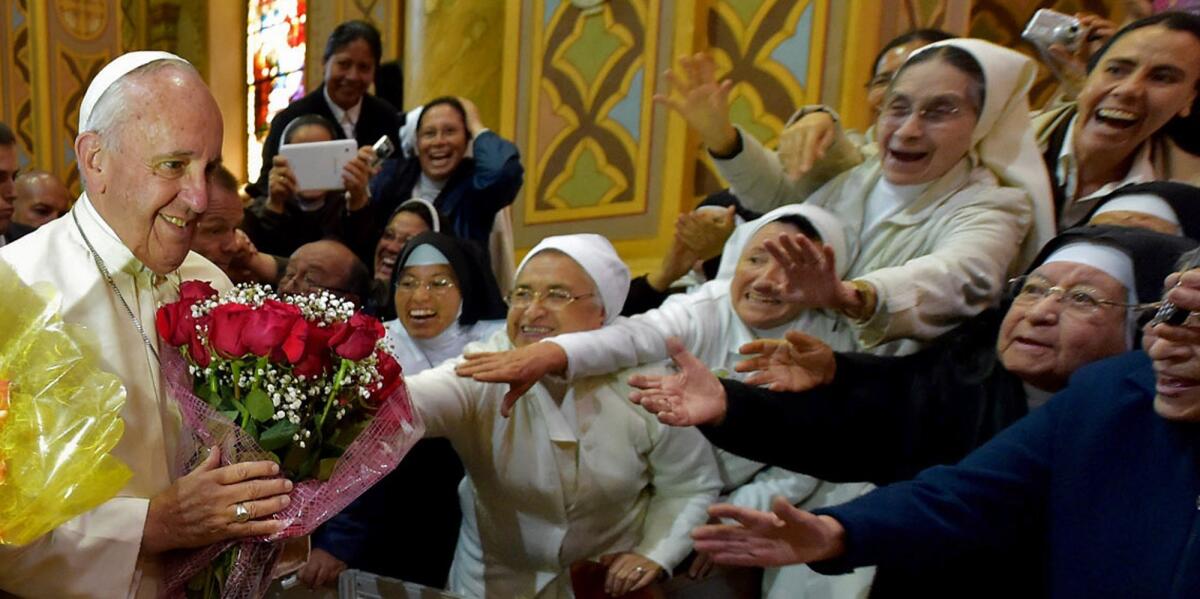Will Pope Francis chew coca? (It’s a thing in Bolivia)

Nuns reach out to Pope Francis as he arrives at the National Shrine of Our Lady of the Presentation of El Quinche in Ecuador on July 8.
- Share via
Reporting from Quito, Ecuador — Pope Francis took his Latin American pilgrimage to the heavily indigenous Andean nation of Bolivia, where his challenge will be to reconcile ethnic communities with traditional Catholicism.
Seen off by Ecuadoran President Rafael Correa, the pope departed this capital about 1 p.m. local time (11 a.m. PDT) for the highest capital in the world, La Paz, where he was scheduled to arrive later Wednesday.
Concern about the altitude — La Paz is more than two miles above sea level, and its airport in neighboring El Alto is even higher — has led to breathless speculation over whether the pope will accept the local remedy for altitude sickness: the chewing of coca leaves.
Coca leaves are the raw ingredient in cocaine, but in their natural state, they are an ancient medicine that is both chewed and used for coca tea. The government of Bolivian President Evo Morales, an indigenous former grower of coca leaves, has said it will offer leaves and tea to the pope — who, at age 78 and missing part of a lung, might be suffering — but the Vatican has not said whether he will accept.
The theme being pronounced by the first pope from the Americas on a three-country tour of his native continent has been the need to include the excluded, be they poor, elderly or indigenous. He also has advocated dialogue that includes “all voices” in a region torn by divisive politics.
Before departing Quito, Francis visited a home for the elderly run by nuns from the order established by Mother Teresa of Calcutta. He greeted, kissed and blessed scores of elderly, many infirm or in wheelchairs. Then he went to the sanctuary of the Virgin del Quinche, patron saint of Ecuador, where he tossed out a speech and spoke off the cuff.
In Bolivia, where Aymara Indians are expected to participate in many of the papal ceremonies, the pope will preach on behalf of a Catholicism that embraces indigenous cultures, despite centuries of history in which Spanish — and Catholic — colonizers subjugated, abused and even slaughtered native peoples. Despite that, Bolivia is a very Catholic country.
“Sometimes it needs work to learn to respect each other … but it is easy to coexist and enrich one another mutually,” Father Eugenio Scarpellini, bishop of El Alto, told the CNN Spanish-language service as he awaited the pope’s arrival.
The pope’s message, he said, will be that Catholicism “does not come to destroy a culture but to plant seeds of the gospel and the values of solidarity and fraternity.”
The pope is expected to spend only about four hours in La Paz before traveling to the Bolivian lowland city of Santa Cruz. After Bolivia, he travels to Paraguay, completing a tour of some of South America’s smallest and poorest nations.
For more news from the pope’s trip, follow @TracyKWilkinson on Twitter
More to Read
Sign up for Essential California
The most important California stories and recommendations in your inbox every morning.
You may occasionally receive promotional content from the Los Angeles Times.














